ເນື້ອໃນ
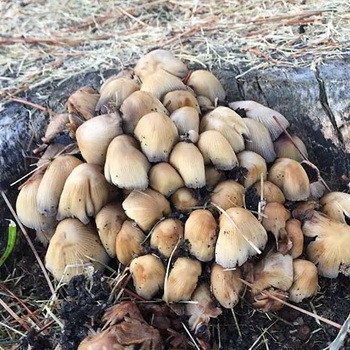 Among the fungi of a bizarre shape can be attributed fruiting bodies that look like eggs. They can be both edible and poisonous. Egg-shaped mushrooms are found in a wide variety of forests, but most often they prefer loose soils, often forming mycorrhiza with coniferous and deciduous trees of various species. The characteristics of the most common egg-shaped mushrooms are presented on this page.
Among the fungi of a bizarre shape can be attributed fruiting bodies that look like eggs. They can be both edible and poisonous. Egg-shaped mushrooms are found in a wide variety of forests, but most often they prefer loose soils, often forming mycorrhiza with coniferous and deciduous trees of various species. The characteristics of the most common egg-shaped mushrooms are presented on this page.
Dung beetle mushrooms in the shape of an egg
Gray dung beetle (Coprinus atramentarius).
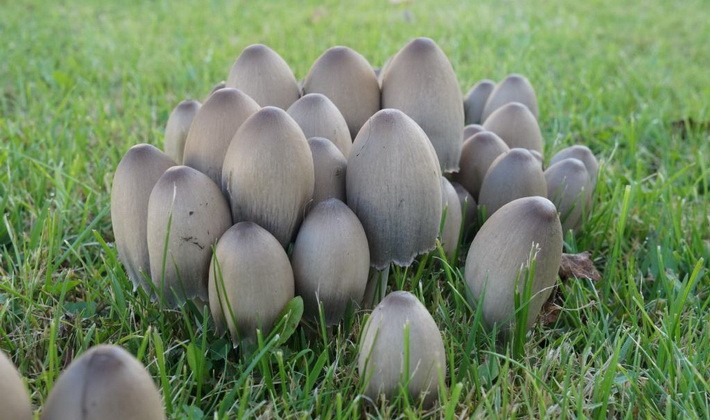
ຄອບຄົວ: Dung beetles (Coprinaceae).
ລະດູການ: end of June – end of October.
ການເຕີບໂຕ: large groups.
ລາຍລະອຽດ:
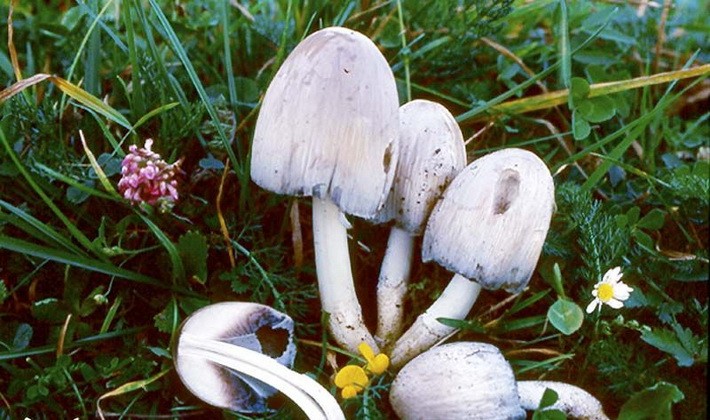
The cap of a young mushroom is ovoid, then broadly bell-shaped.

The flesh is light, quickly darkening, sweetish in taste. The surface of the cap is gray or grayish-brown, darker in the center, with small, darkish scales. The ring is white, quickly disappears. The edge of the cap is cracking.
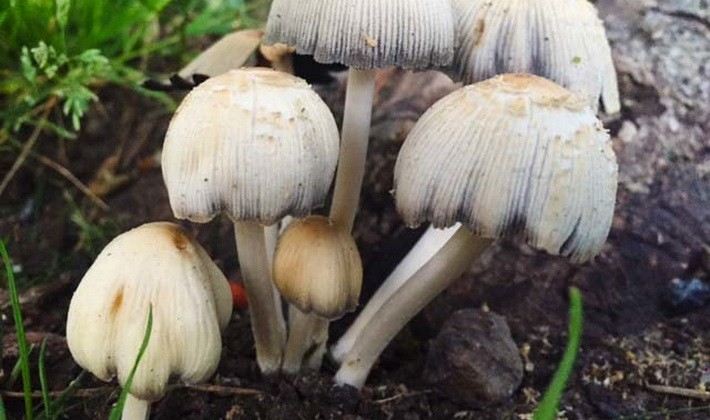
The stalk is white, slightly brownish at the base, smooth, hollow, often strongly curved. The plates are free, wide, frequent; young mushrooms are white, turn black in old age, then autolyse (blur into a black liquid) along with the cap.
ເຫັດກິນໄດ້ຕາມເງື່ອນໄຂ. Edible only at a young age after preliminary boiling. Drinking with alcoholic beverages causes poisoning.
ນິເວດວິທະຍາແລະການແຜ່ກະຈາຍ:
Grows on humus-rich soils, in fields, gardens, landfills, near manure and compost heaps, in forest clearings, near trunks and stumps of hardwoods.
White dung beetle (Coprinus comatus).
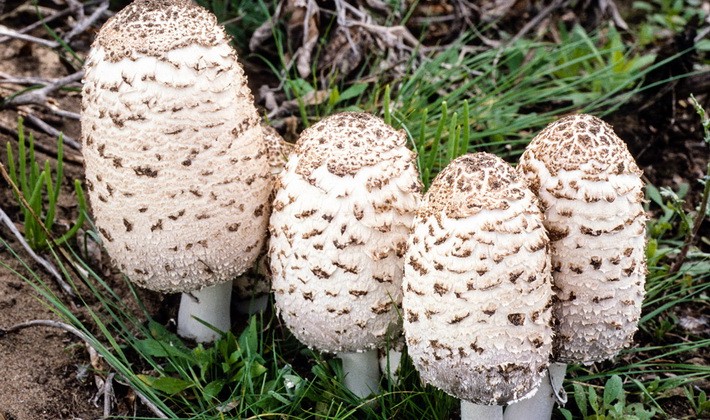
ຄອບຄົວ: Dung beetles (Coprinaceae).
ລະດູການ: mid-August – mid-October.
ການເຕີບໂຕ: large groups.
ລາຍລະອຽດ:
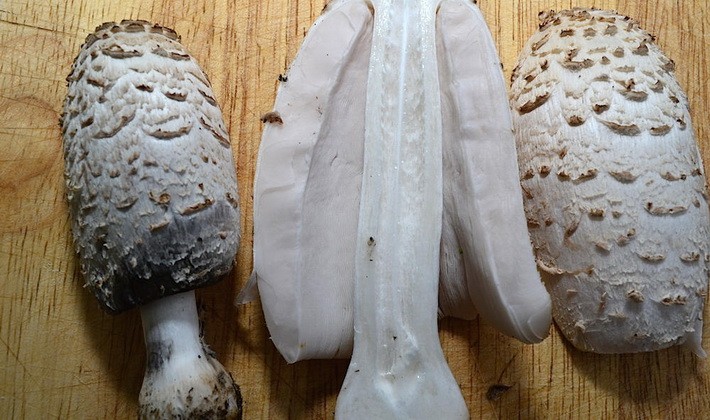
The pulp is white, soft. There is a brown tubercle at the top of the cap.
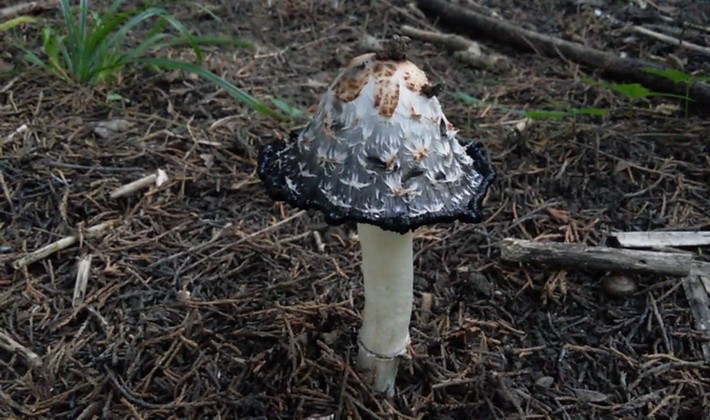
The leg is white, with a silky sheen, hollow. In old mushrooms, the plates and cap are autolyzed.
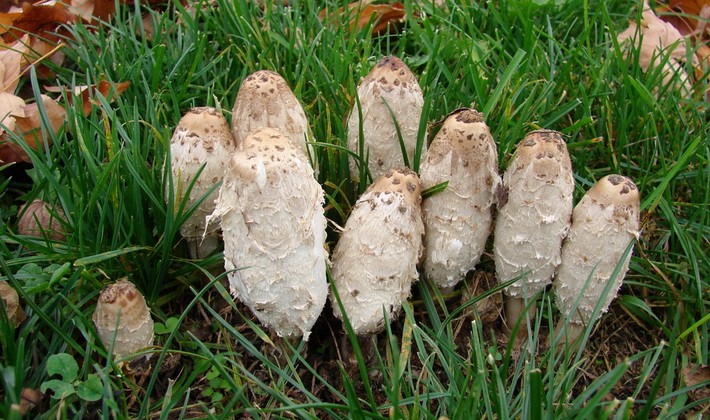
The cap of a young fungus is elongated ovoid, then narrowly bell-shaped, whitish or brownish, covered with fibrous scales. With age, the plates begin to turn pink from below. The plates are free, wide, frequent, white.
The mushroom is edible only at a young age (before the plates darken). Must be processed on the day of collection; it is recommended to pre-boil. Should not be mixed with other mushrooms.
ນິເວດວິທະຍາແລະການແຜ່ກະຈາຍ:
It grows on loose soils rich in organic fertilizers, in pastures, vegetable gardens, gardens and parks.
Flickering dung beetle (Coprinus micaceus).
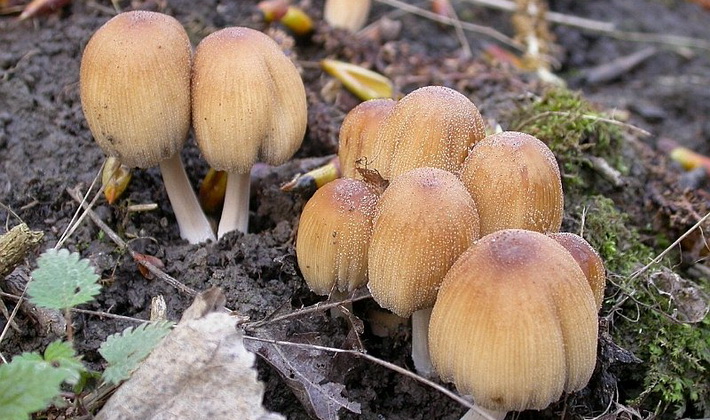
ຄອບຄົວ: Dung beetles (Coprinaceae).
ລະດູການ: end of May – end of October.
ການເຕີບໂຕ: groups or clusters.
ລາຍລະອຽດ:
The skin is yellow-brown, in young mushrooms it is covered with very small granular scales formed from a thin common plate. The plates are thin, frequent, wide, adherent; the color is whitish at first, then they turn black and blur.
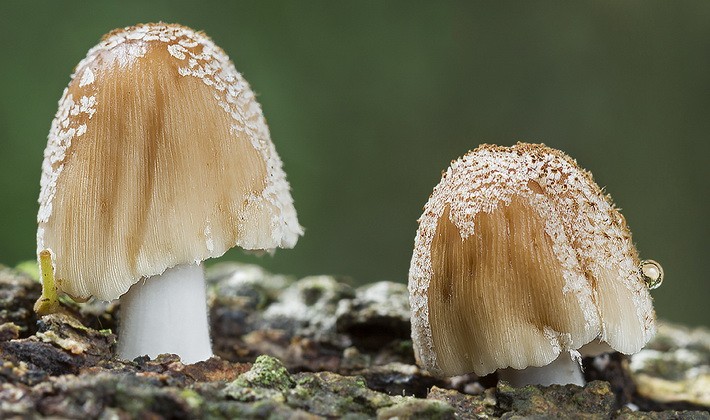
The pulp at a young age is white, sour taste.

Leg whitish, hollow, fragile; its surface is smooth or slightly silky. The edge of the cap is sometimes torn.
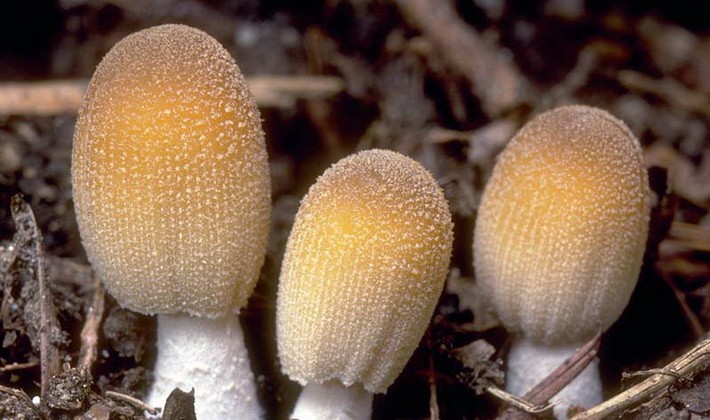
The cap is bell-shaped or ovoid with a furrowed surface.
ເຫັດກິນໄດ້ຕາມເງື່ອນໄຂ. Usually not collected due to small size and fast autolysis of caps. Used fresh.
ນິເວດວິທະຍາແລະການແຜ່ກະຈາຍ:
It grows both in forests, on the wood of deciduous trees, and in city parks, courtyards, on stumps or on the roots of old and damaged trees.
Egg-like dung mushrooms are shown in these photos:
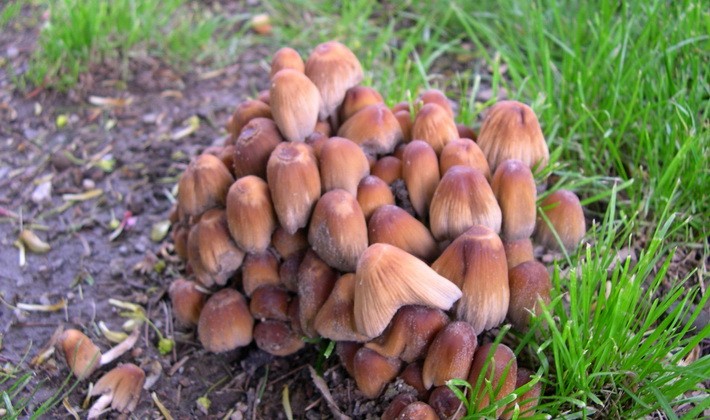
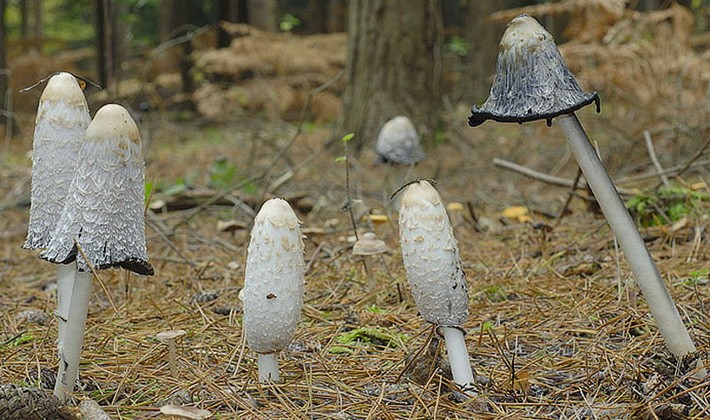
Veselka mushroom or devil’s (witch’s) egg
Veselka ordinary (Phallus impudicus) or devil’s (witch’s) egg.
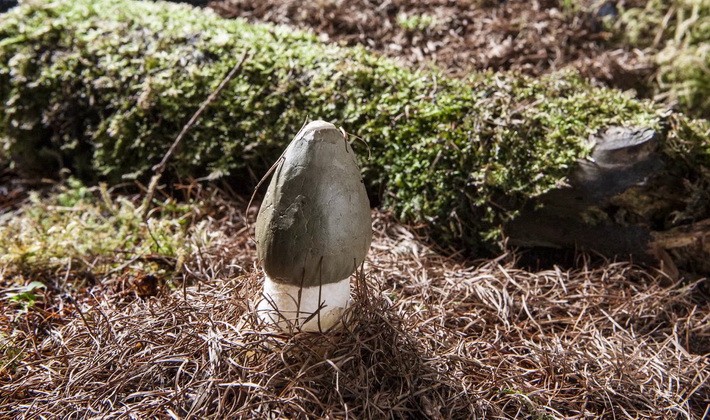
ຄອບຄົວ: Veselkovye (Phallaceae).
ລະດູການ: ພຶດສະພາ – ຕຸລາ.
ການເຕີບໂຕ: ຢູ່ຄົນດຽວ ແລະເປັນກຸ່ມ
Description of the fungus Veselka (devil’s egg):

Remains of the egg shell. The mature cap is bell-shaped, with a hole at the top, covered with dark olive mucus with the smell of carrion. The growth rate after maturation of the egg reaches 5 mm per minute. When the spore-bearing layer is eaten by insects, the cap becomes cotton wool with clearly visible cells.

The leg is spongy, hollow, with thin walls.

The young fruiting body is semi-underground, oval-spherical or ovoid, 3-5 cm in diameter, off-white.
Young fruiting bodies, peeled from the egg shell and fried, are used for food.
Ecology and distribution of fungus Veselka (witch’s egg):
It grows most often in deciduous forests, prefers soils rich in humus. The spores are spread by insects attracted by the smell of the fungus.
Other egg-like mushrooms
Mutinus canine (Mutinus caninus).

ຄອບຄົວ: Veselkovye (Phallaceae).
ລະດູການ: end of June – September.
ການເຕີບໂຕ: ດ່ຽວ ແລະ ເປັນກຸ່ມ.
ລາຍລະອຽດ:

The pulp is porous, very tender. When ripe, the small tuberculate tip of the “leg” is covered with brown-olive spore-bearing mucus with the smell of carrion. When insects gnaw at the mucus, the top of the fruit body turns orange and then the entire fruit body begins to decompose rapidly.
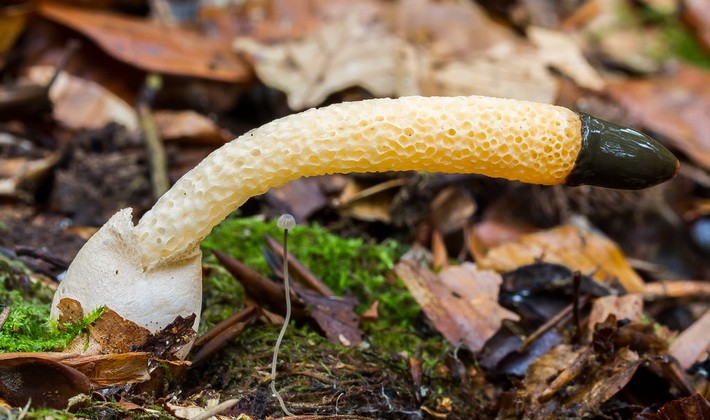
The “leg” is hollow, spongy, yellowish. The young fruiting body is ovoid, 2–3 cm in diameter, light, with a root process.
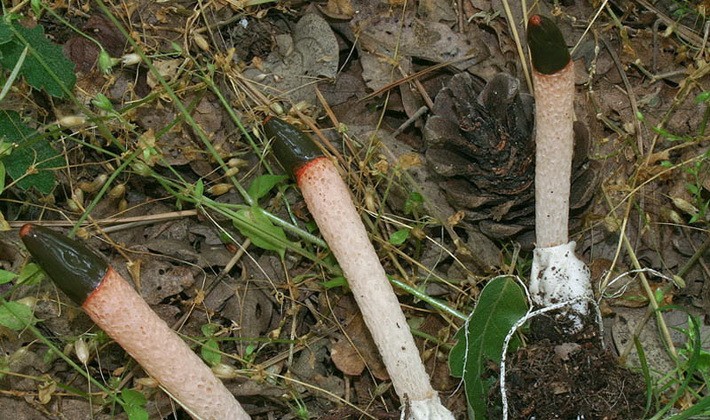
The skin of the egg remains a sheath at the base of the “leg”.
This egg-like mushroom is considered inedible. According to some reports, young fruiting bodies in the egg shell can be eaten.
ນິເວດວິທະຍາແລະການແຜ່ກະຈາຍ:
Grows in coniferous forests, usually near rotten deadwood and stumps, sometimes on sawdust and rotting wood.
Cystoderma scaly (Cystoderma carcharias).

ຄອບຄົວ: ແຊມປີນ (Agaricaceae).
ລະດູການ: mid-August – November.
ການເຕີບໂຕ: ຢູ່ຄົນດຽວ ແລະເປັນກຸ່ມນ້ອຍ.
ລາຍລະອຽດ:
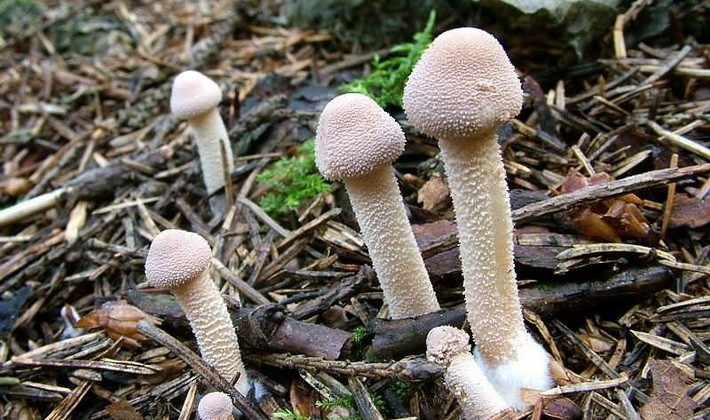
The cap of young mushrooms is conical or ovoid. The cap of mature mushrooms is flat-convex or prostrate. The plates are frequent, thin, adherent, with intermediate plates, whitish.

The leg is slightly thickened towards the base, granular-scaly, of the same color as the cap.
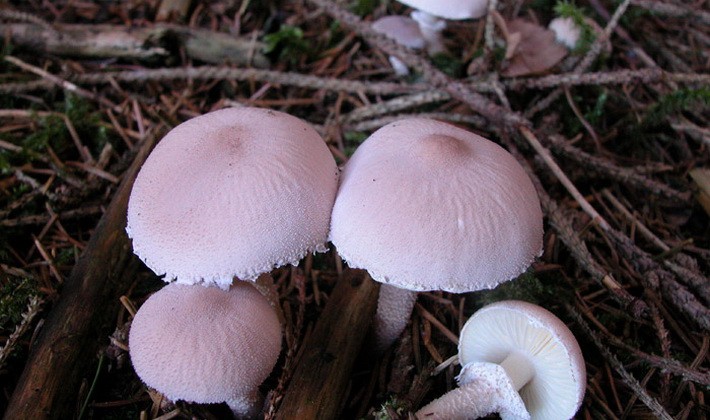
The flesh is brittle, pale pink or white, with a woody or earthy odor.
The mushroom is considered conditionally edible, but its taste is low. Almost never eaten.
ນິເວດວິທະຍາແລະການແຜ່ກະຈາຍ:
It grows in coniferous and mixed (with pine) forests, on chalky soils, in moss, on litter. Very rare in deciduous forests.
Caesar mushroom (Amanita caesarea).
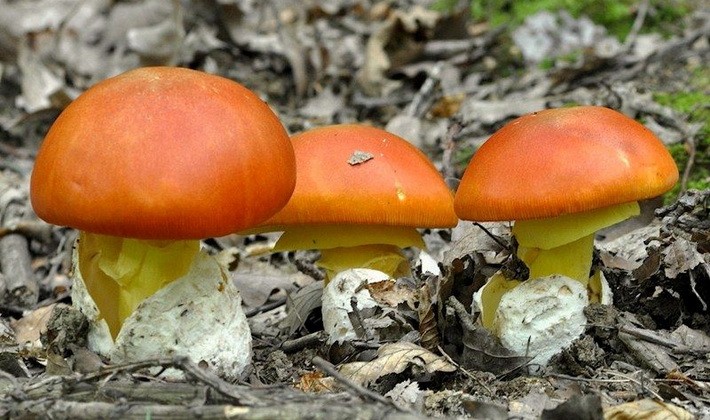
ຄອບຄົວ: Amanitaceae (Amanitaceae).
ລະດູການ: ເດືອນມິຖຸນາ - ຕຸລາ.
ການເຕີບໂຕ: ດຽວ.
ລາຍລະອຽດ:
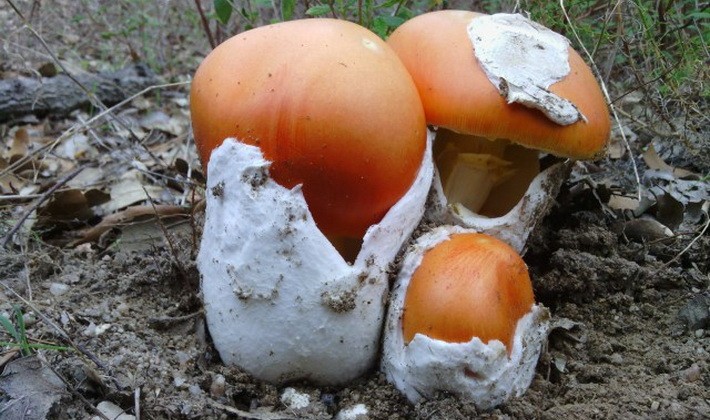
The cap of young mushrooms is ovoid or hemispherical. The cap of mature mushrooms is convex or flat, with a furrowed edge. In the “egg” stage, the Caesar mushroom can be confused with a pale toadstool, from which it differs in the cut: yellow cap skin and a very thick common veil.
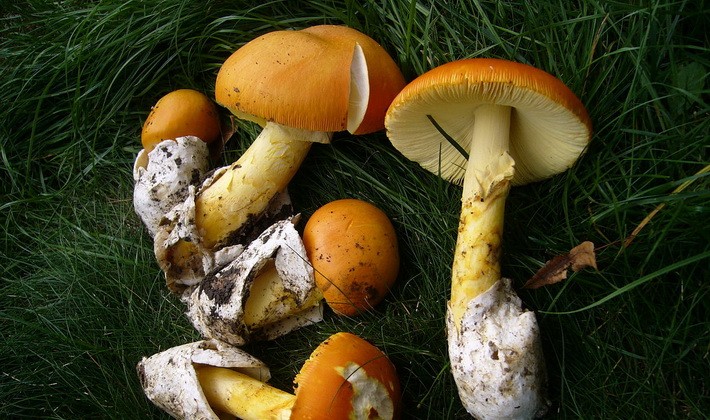
The skin is golden-orange or bright red, dry, usually without the remains of the coverlet. The outside is white, the inner surface may be yellowish. The Volvo is free, bag-shaped, up to 6 cm wide, up to 4-5 mm thick.

The flesh of the cap is fleshy, light yellow under the skin. The plates are golden yellow, free, frequent, wide in the middle part, the edges are slightly fringed. The flesh of the leg is white, without a characteristic smell and taste.
Since ancient times, it has been considered one of the best delicacies. A mature mushroom can be boiled, grilled or fried, the mushroom is also suitable for drying and pickling. Young mushrooms covered with unbroken volva are used raw in salads.
ນິເວດວິທະຍາແລະການແຜ່ກະຈາຍ:
Forms mycorrhiza with beech, oak, chestnut and other hardwoods. It grows on soil in deciduous, occasionally in coniferous forests, prefers sandy soils, warm and dry places. Widespread in the Mediterranean subtropics. In the countries of the former USSR, it is found in the western regions of Georgia, in Azerbaijan, in the North Caucasus, in the Crimea and Transcarpathia. Fruiting requires stable warm weather (not lower than 20 ° C) for 15-20 days.
ປະເພດທີ່ຄ້າຍຄືກັນ.
From the red fly agaric (the remains of the bedspread from the hat of which are sometimes washed off), the Caesar mushroom differs in the yellow color of the ring and plates (they are white in the fly agaric).
Pale grebe (Amanita phalloides).
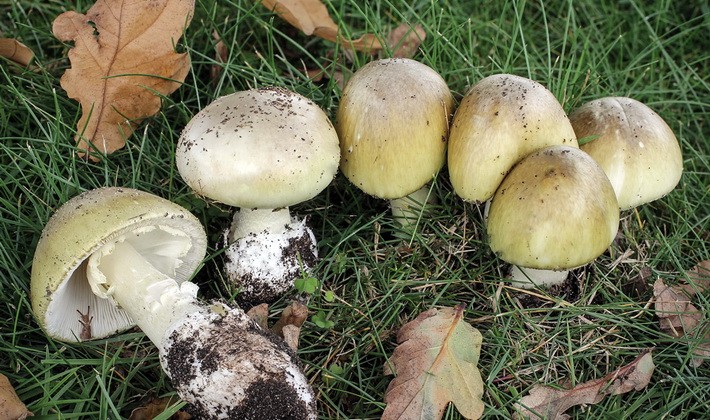
ຄອບຄົວ: Amanitaceae (Amanitaceae).
ລະດູການ: beginning of August – mid-October.
ການເຕີບໂຕ: ດ່ຽວ ແລະ ເປັນກຸ່ມ.
ລາຍລະອຽດ:
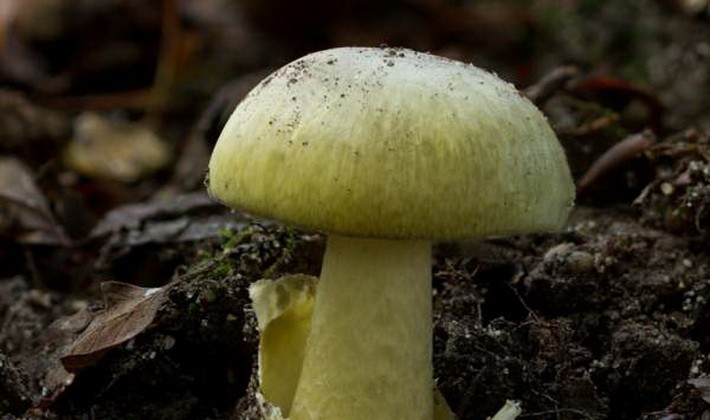
The hat is olive, greenish or grayish, from hemispherical to flat, with a smooth edge and a fibrous surface. The plates are white, soft, free.
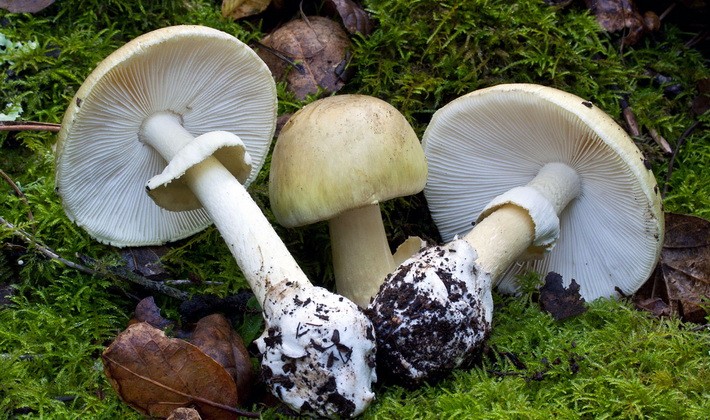
The stem is the color of a hat or whitish, often covered with a moire pattern. The volva is well-defined, free, lobed, white, 3-5 cm wide, often half-immersed in the soil. The ring is wide at first, fringed, striped outside, often disappears with age. On the skin of the cap remnants of the veil are usually absent. The fruit body at a young age is ovoid, completely covered with a film.
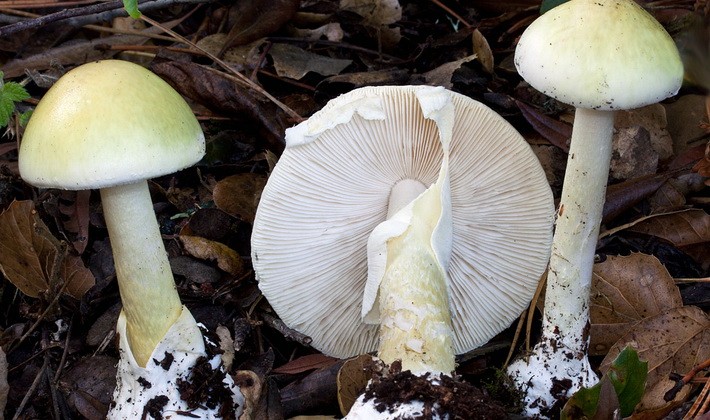
The flesh is white, fleshy, does not change color when damaged, with a mild taste and smell. Thickening at the base of the leg.
One of the most dangerous poisonous mushrooms. Contains bicyclic toxic polypeptides that are not destroyed by heat treatment and cause fatty degeneration and liver necrosis. The lethal dose for an adult is 30 g of mushroom (one hat); for a child – a quarter of a hat. Poisonous are not only fruiting bodies, but also spores, so other mushrooms and berries should not be collected near the pale grebe. A particular danger of the fungus lies in the fact that signs of poisoning do not appear for a long time. In the period from 6 to 48 hours after consumption, indomitable vomiting, intestinal colic, muscle pain, unquenchable thirst, cholera-like diarrhea (often with blood) appear. There may be jaundice and an enlarged liver. The pulse is weak, blood pressure is lowered, loss of consciousness is observed. There are no effective treatments after the onset of symptoms. On the third day, a “period of false well-being” begins, which usually lasts from two to four days. In fact, the destruction of the liver and kidneys continues at this time. Death usually occurs within 10 days of poisoning.
ນິເວດວິທະຍາແລະການແຜ່ກະຈາຍ:
Forms mycorrhiza with various deciduous species (oak, beech, hazel), prefers fertile soils, light deciduous and mixed forests.
Forest mushroom (Agaricus silvaticus).
ຄອບຄົວ: ແຊມປີນ (Agaricaceae).
ລະດູການ: end of June – mid-October.
ການເຕີບໂຕ: ຢູ່ໃນກຸ່ມ.
ລາຍລະອຽດ:

The plates are white at first, then dark brown, narrowed towards the ends. The flesh is white, reddening when broken.
The cap is ovate-bell-shaped, flat procumbent when ripe, brown-brown, with dark scales.
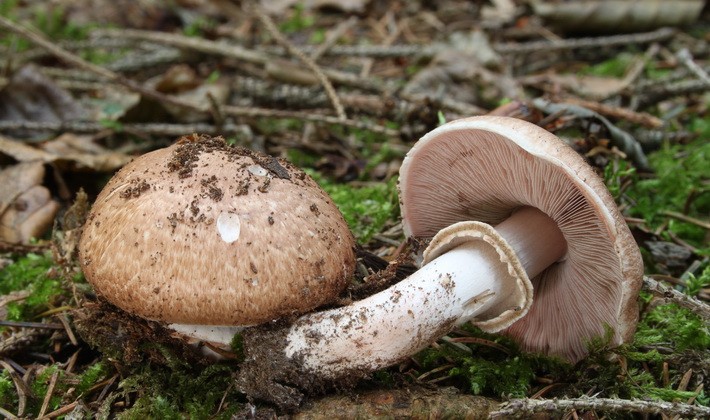
The stem is cylindrical, often slightly swollen towards the base. The membranous white ring of the egg-like fungus often disappears in maturity.
ເຫັດກິນໄດ້ແຊບ. Used fresh and pickled.
ນິເວດວິທະຍາແລະການແຜ່ກະຈາຍ:
It grows in coniferous (spruce) and mixed (with spruce) forests, often near or on ant heaps. Appears abundantly after rains.
Cinnabar Red Cinnabar (Calostoma cinnabarina).
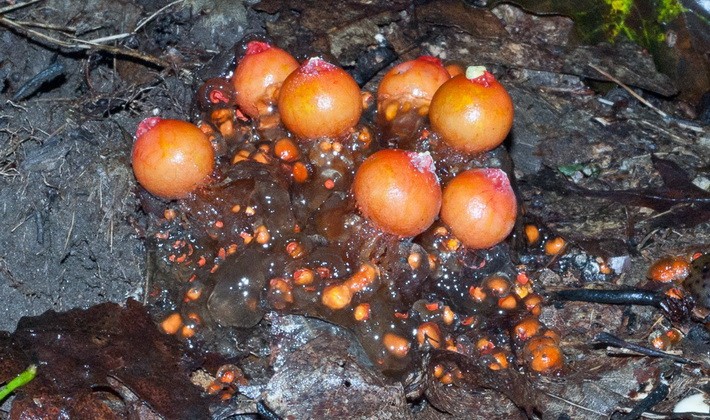
ຄອບຄົວ: ຝົນທີ່ບໍ່ຖືກຕ້ອງ (Sclerodermataceae).
ລະດູການ: ທ້າຍລະດູຮ້ອນ - ລະດູໃບໄມ້ປົ່ງ.
ການເຕີບໂຕ: ດ່ຽວ ແລະ ເປັນກຸ່ມ.
ລາຍລະອຽດ:
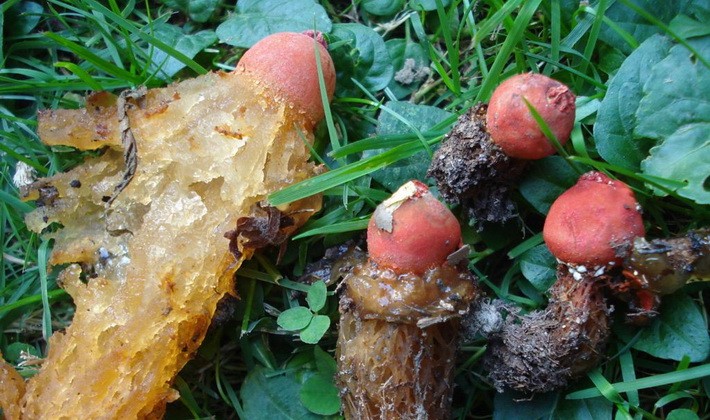
The false leg is porous, surrounded by a gelatinous membrane.
The outer shell of the fruit body breaks and peels off. As it matures, the stem lengthens, raising the fruit above the substrate.
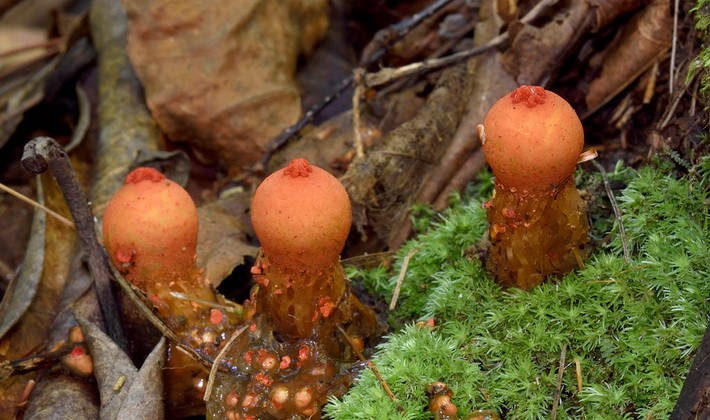
The fruit body is round, ovoid or tuberous, in young mushrooms from red to red-orange, enclosed in a three-layered shell.
ກິນບໍ່ໄດ້.
ນິເວດວິທະຍາແລະການແຜ່ກະຈາຍ:
It grows on the soil, in deciduous and mixed forests, on the edges, along roadsides and paths. Prefers sandy and clay soils. Common in North America; in Our Country occasionally found in the south of Primorsky Krai.
Warty puffball (Scleroderma verrucosum).
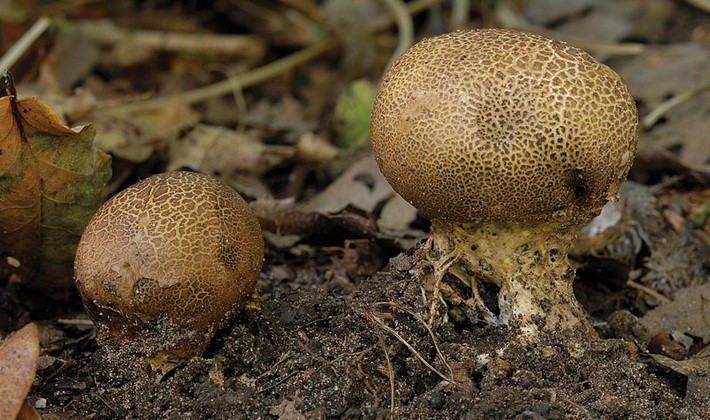
ຄອບຄົວ: ຝົນທີ່ບໍ່ຖືກຕ້ອງ (Sclerodermataceae).
ລະດູການ: ສິງຫາ – ຕຸລາ.
ການເຕີບໂຕ: ດ່ຽວ ແລະ ເປັນກຸ່ມ.
ລາຍລະອຽດ:
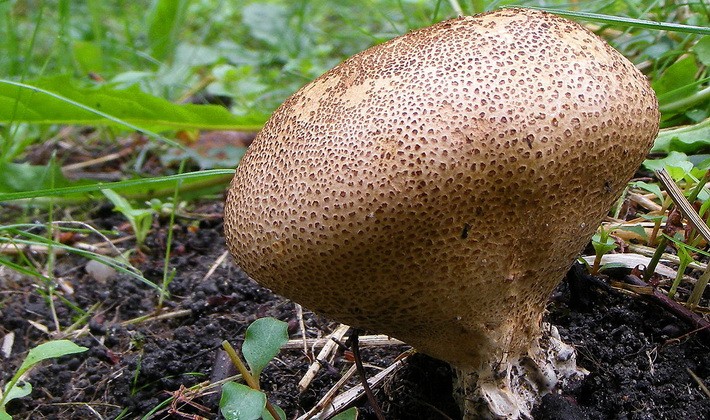
The fruiting body is tuberous or kidney-shaped, often flattened from above. The skin is thin, cork-skinned, off-white, then ocher-yellow with brownish scales or warts.
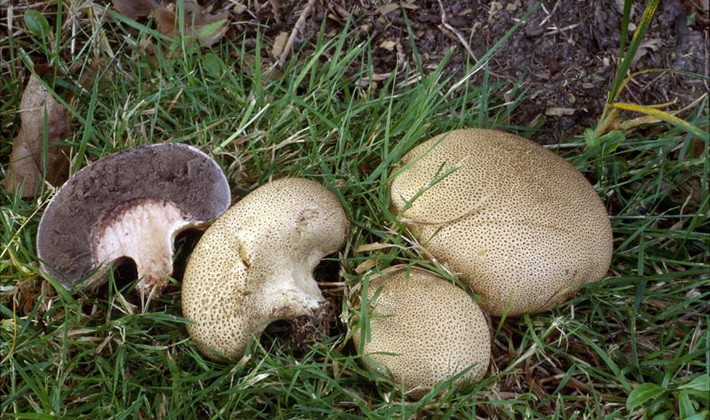
When ripe, the pulp becomes flabby, grayish-black, acquiring a powdery structure. Root-like outgrowth from wide flat mycelial strands.
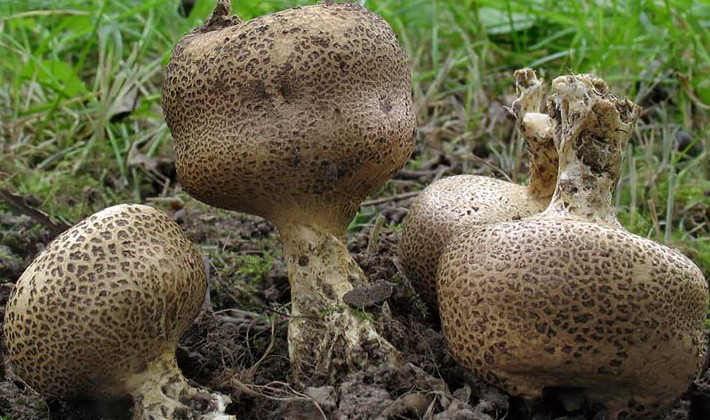
The false pedicle is often elongated.
Slightly poisonous mushroom. In large quantities, it causes poisoning, accompanied by dizziness, stomach cramps, and vomiting.
ນິເວດວິທະຍາແລະການແຜ່ກະຈາຍ: Grows on dry sandy soils in forests, gardens and parks, in clearings, often on roadsides, edges of ditches, along paths.
Sack-shaped golovach (Calvatia utriformis).
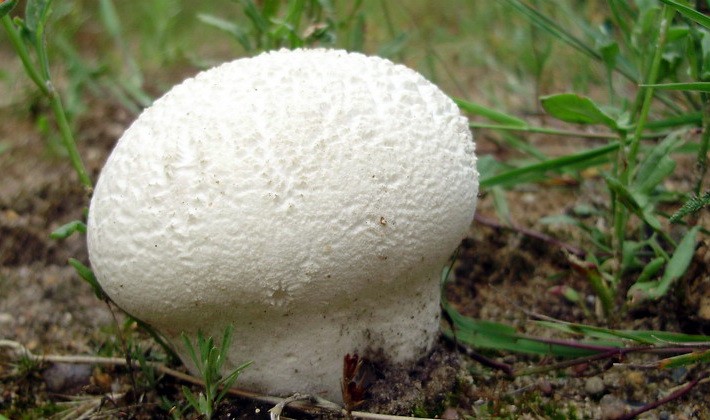
ຄອບຄົວ: ແຊມປີນ (Agaricaceae).
ລະດູການ: ທ້າຍເດືອນພຶດສະພາ - ກາງເດືອນກັນຍາ.
ການເຕີບໂຕ: ຢູ່ຄົນດຽວ ແລະເປັນກຸ່ມນ້ອຍ.
ລາຍລະອຽດ:
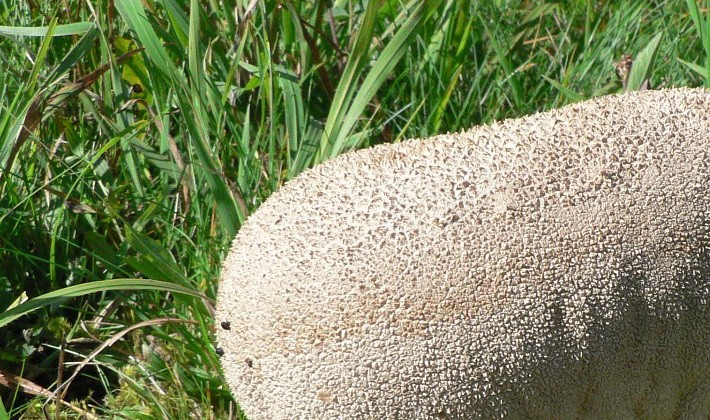
The fruit body is broadly ovate, saccular, flattened from above, with a base in the form of a false leg. The outer shell is thick, woolly, at first white, later turns yellow and turns brown.
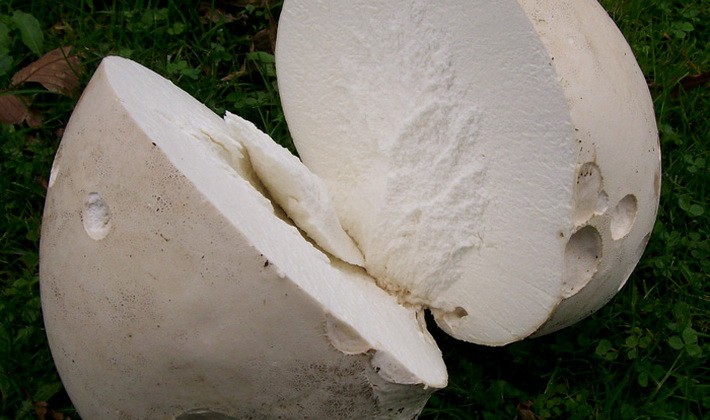
The flesh is white at first, then turns greenish and dark brown.

A mature mushroom cracks, breaks at the top and disintegrates.
Young mushrooms with white flesh are edible. Used boiled and dried. Has a hemostatic effect.
ນິເວດວິທະຍາແລະການແຜ່ກະຈາຍ:
It grows in deciduous and mixed forests, on edges and clearings, in meadows, pastures, pastures, on arable land.









